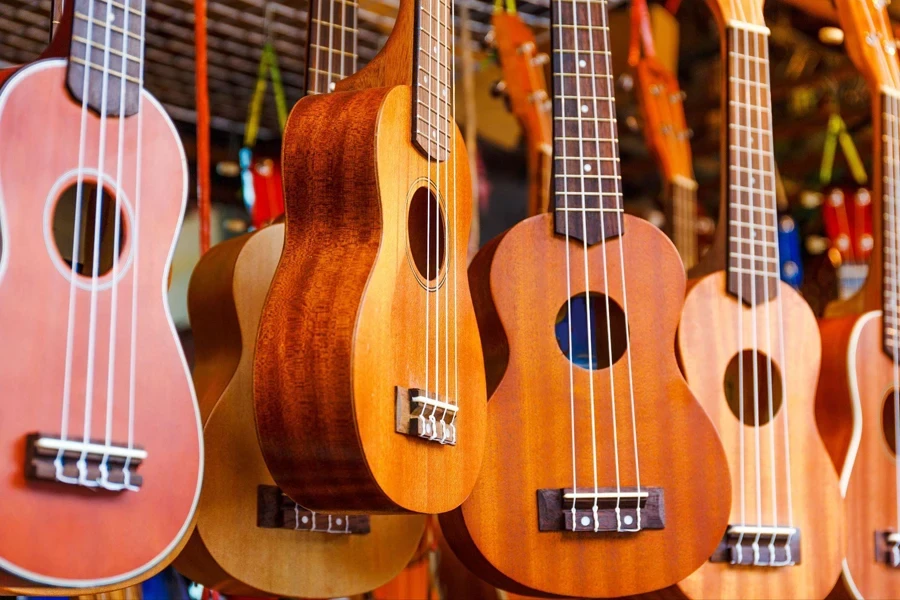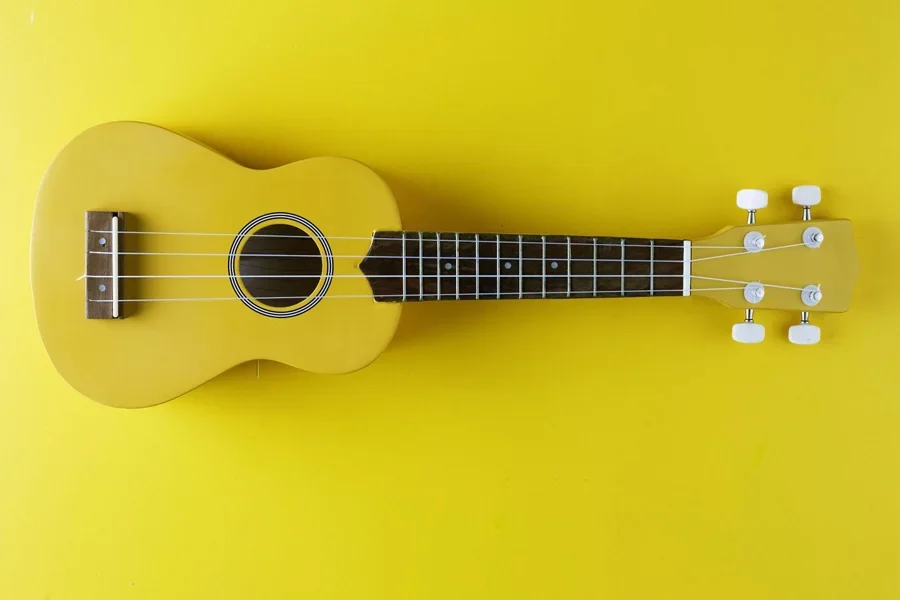Table of Contents
– Introduction
– What is a Ukulele?
– Ukulele Market Overview
– Types of Ukuleles
– Ukulele Tuning Basics
– Step-by-Step Guide to Tuning a Ukulele
– Maintaining the Ukulele’s Tuning
– Conclusion
Introduction
The ukulele has surged in popularity in recent years, captivating music enthusiasts with its charming sound and portability. Whether you’re a beginner looking to dive into the world of ukuleles or an experienced player seeking to expand your collection, selecting the right instrument and mastering the art of tuning are crucial steps in your musical journey.
What is a Ukulele?
A ukulele is a compact, four-stringed instrument that originated in Hawaii, offering a unique blend of portability and musical versatility. As a member of the lute family, it typically features nylon strings, providing a warm, mellow tone that’s become increasingly popular in various musical genres. The ukulele’s size and construction significantly influence its acoustic properties, with options ranging from the bright, crisp sound of soprano models to the fuller, more resonant tones of tenor and baritone varieties. For businesses in the music industry, ukuleles represent a high-margin product line with broad appeal, from beginners to professional musicians. Their relatively low production costs, combined with growing market demand, make ukuleles an attractive inventory option for music retailers and wholesalers alike.
Ukulele Market Overview
The global ukulele market has been experiencing robust growth in recent years, driven by increasing popularity among musicians of all skill levels and the instrument’s versatility across various musical genres. According to recent market research, the ukulele market was valued at approximately USD 100 million in 2023 and is projected to reach USD 150 million by 2030. This represents a compound annual growth rate (CAGR) of 5% during the forecast period from 2024 to 2030.

In terms of regional market share, North America currently dominates the global ukulele market, benefiting from expanding industrial development and increasing adoption among professional players, educators, and amateur musicians. China is also a significant player, holding a market share of over 80%, followed by Europe and the United States, which collectively account for approximately 15% of the market.
The competitive landscape of the ukulele market is characterized by a mix of established manufacturers and emerging players. The top three global manufacturers hold a combined market share of over 20%, indicating a relatively concentrated market at the upper end. Key players in the industry include TOM, Enya Music, KALA Ukulele, and Yufeng Musical Instrument (Fujian) Co., Ltd., among others.
Types of Ukuleles
There are four main types of ukuleles: soprano, concert, tenor, and baritone.
Soprano
Soprano ukuleles, the smallest and most traditional variant, are a cornerstone product in the ukulele market. Typically measuring 21 inches in length, these instruments produce a bright, punchy sound that epitomizes the classic ukulele tone. Their compact size makes them highly portable and appealing to a wide range of consumers, from beginners to traveling musicians. Soprano ukuleles often represent an attractive entry point for retailers, with price points ranging from $19.99 to $89.99 for quality models. This affordability, combined with their authentic Hawaiian heritage, positions soprano ukuleles as high-turnover inventory items with broad market appeal. For businesses, they offer an excellent opportunity to capture both the budget-conscious and collector segments of the musical instrument market.

Concert
Concert ukuleles, measuring approximately 23 inches in length, offer a strategic balance between the compact soprano and the larger tenor models. With a scale length of about 15 inches, they provide increased fretboard space, enhancing playability for adults and those with larger hands. This size delivers a rich, well-rounded tone that maintains the bright, traditional ukulele sound while offering improved volume and resonance. For retailers, concert ukuleles represent an excellent mid-range option, typically priced between $99 and $499, appealing to both beginners seeking comfort and experienced players desiring versatility. Their popularity in educational settings and growing demand among hobbyists make concert ukuleles a high-turnover inventory item with strong profit potential.
Tenor
Tenor ukuleles, typically measuring 26 inches in length, represent the largest of the three main ukulele types and offer a compelling value proposition for retailers. With a scale length of 17-18 inches, tenors produce a deeper, fuller tone with enhanced resonance and projection, making them highly sought after by professional musicians and discerning hobbyists alike. The extended fretboard, featuring 18-19 frets, provides greater versatility for complex fingerpicking and chord progressions. Tenor models command premium price points, ranging from $67.99 to $562.33 for high-end instruments, offering attractive profit margins. Their popularity among professionals and as upgrades for intermediate players positions tenor ukuleles as a high-value inventory item with strong sales potential and customer retention opportunities.

Baritone
Baritone ukuleles represent a unique market opportunity, tuned to DGBE (identical to the top four strings of a guitar) and offering a deeper, more resonant tone that bridges the gap between ukulele and guitar markets. With a typical scale length of 19 inches, baritones provide enhanced playability for adult hands and appeal to both ukulele enthusiasts seeking a fuller sound and guitarists looking for a familiar fingering pattern. While less common than standard-tuned ukuleles, baritones command higher price points, ranging from $79.99 to $3,345 for premium models, offering attractive profit margins. Their distinctive niche allows retailers to diversify inventory and target crossover musicians, despite the relative scarcity of baritone-specific arrangements. This presents an opportunity for bundled sales of instructional materials or custom string sets for those preferring standard GCEA tuning.
Ukulele Tuning Basics
Proper tuning is essential for any ukulele player. Understanding the basics of tuning and having the right tools will ensure your instrument always sounds its best.
Standard Tuning (G-C-E-A)
The standard G-C-E-A tuning for soprano, concert, and tenor ukuleles represents the cornerstone of ukulele inventory management. This versatile tuning, also known as “C tuning” or “My Dog Has Fleas,” accounts for the majority of ukulele sales and educational materials. The unique re-entrant tuning, with the G string (G4) pitched higher than the C string (C4), creates the instrument’s distinctive bright, cheerful tone that drives consumer demand. This standardization across three size categories (soprano, concert, and tenor) allows retailers to streamline inventory and educational resources, maximizing profit potential and minimizing stock complexity. The G-C-E-A tuning’s popularity ensures broad compatibility with available sheet music and online tutorials, enhancing customer satisfaction and reducing returns due to tuning confusion.

Alternate Tunings
While standard G-C-E-A tuning dominates the ukulele market, alternate tunings offer retailers a unique opportunity to diversify their product offerings and target niche segments. Popular alternatives like D-tuning (A-D-F#-B) and low-G tuning cater to players seeking traditional Hawaiian sounds or extended range, respectively. These tunings often require specialized string sets, presenting an opportunity for increased accessory sales. Slack-key tunings (e.g., G-C-E-G) appeal to folk and blues enthusiasts, while open tunings like C6 (G-C-E-A) attract players from guitar and lap steel backgrounds. Stocking instruments pre-configured for these tunings, or offering tuning conversion services, can differentiate a retailer in a competitive market and appeal to more advanced players willing to invest in multiple instruments for various musical styles.
Step-by-Step Guide to Tuning a Ukulele
Follow these steps to tune the ukulele:
Using an Electronic Tuner
1. Clip the tuner to the headstock of the ukulele.
2. Pluck each string individually and adjust the tuning pegs until the tuner indicates the correct note.
Tuning by Ear
Tuning Using a Piano or Another Instrument
1. Play the corresponding notes (G, C, E, A) on the reference instrument.
2. Pluck each ukulele string and adjust the tuning pegs until the pitch matches the reference notes.
Tuning Using Pitch Pipes
1. Blow into the pitch pipe to produce the desired note (G, C, E, or A).
2. Pluck the corresponding ukulele string and adjust the tuning peg until the pitch matches the pitch pipe.
Troubleshooting Common Tuning Issues
If you encounter difficulties while tuning, check for issues such as old strings, loose tuning pegs, or intonation problems. Consulting a professional can help resolve persistent tuning issues.

Maintaining the Ukulele’s Tuning
To maximize inventory turnover and minimize customer returns, implement these strategic tuning maintenance protocols:
Regular Maintenance Tips
Check tuning before playing: Institute a pre-sale quality control process where staff tune each ukulele before customer demonstrations, ensuring optimal sound quality and increasing conversion rates. Store in a climate-controlled environment: Invest in humidity-controlled display cases (40-55% relative humidity) to preserve inventory value and reduce warranty claims related to wood warping or cracking.
Dealing with New Strings
Implement a “break-in” period for new stock, where staff regularly tune and play instruments to stretch strings, reducing customer frustration and potential returns. Consider offering this as a value-added service for premium models.
Keeping the Tuners Tight
Conduct regular quality checks on tuning mechanisms. For friction tuners, adjust tension screws to optimal levels. For geared tuners, ensure proper lubrication to prevent slippage. This proactive approach can significantly reduce post-sale customer service issues and enhance brand reputation.
Conclusion
Selecting the right ukulele and mastering the art of tuning are essential steps in your musical journey. By considering factors such as size, tonewood, brand, and budget, you can find the perfect ukulele that suits your playing style and preferences. Regular tuning and maintenance will keep your instrument sounding its best. As you continue to practice and explore, you’ll discover the joy and satisfaction of playing the ukulele. Consistent practice is key to improving your ukulele skills. Set aside dedicated time each day to play and experiment with different techniques and styles. As you progress, delve into more advanced techniques such as fingerpicking, strumming patterns, and playing melodies. The ukulele offers endless possibilities for musical expression and growth.



